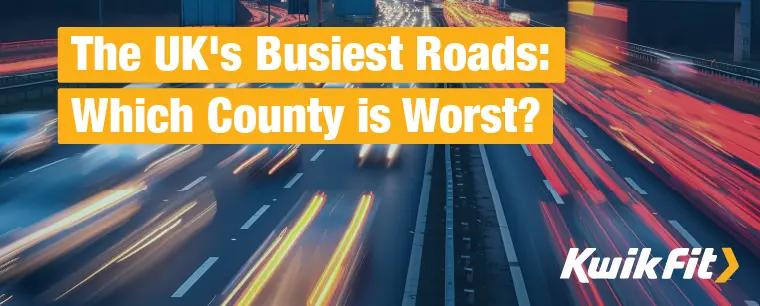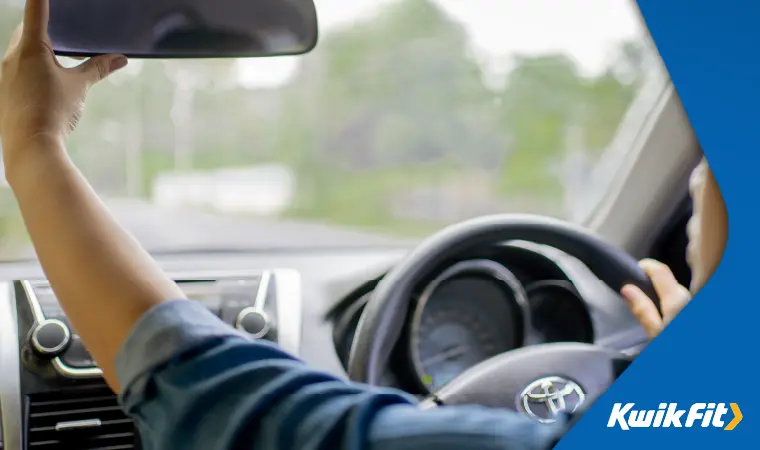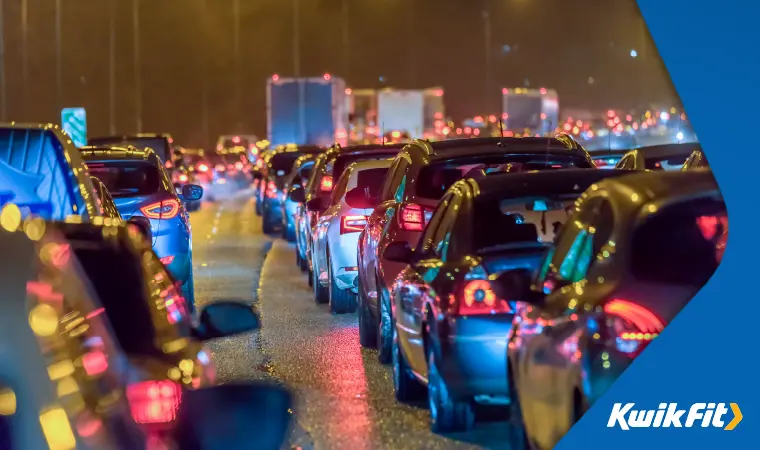The UK's Busiest Roads: Which County is Worst?
Jack Dreyer | Friday 8th March 2024 8:30am

As of September 2023, there were over 41.3 million licensed vehicles in the UK — an increase of 1.4% from the previous year.
From inner-city tailbacks at traffic lights to motorway standstills, the UK is quite notorious for the high volume of traffic on its roads. But which region is the worst? In this blog, using the latest figures from the Department for Transport, we unpack where in the UK has the busiest roads before giving you some tried and tested tips on dealing with traffic at peak times so that you can stay safe out there.
Which roads are the busiest?
Currently, Great Britain has approximately 245,000 miles of road. Of this, 2,300 miles are motorways and 29,600 miles are ‘A’ roads — leaving a whopping 213,100 miles of ‘B’, ‘C’, and ‘U’ roads. But which of these are the busiest?
The Department for Transport has released estimated motor vehicle traffic figures for the local authorities in the UK that rank the highest for estimated traffic per county in vehicle miles (billions). In this research, ‘traffic’ is calculated by multiplying the average annual daily flow of traffic by the corresponding length of road and the number of days in the given year. The top 5 counties are as follows:
- Essex (9.4)
- Hampshire (9.2)
- Kent (9.2)
- Surrey (8.3)
- Hertfordshire (7.2)
When looking deeper at the core features of the road systems in these counties, these results are not surprising at all. Essex, for example, is very large, for one, but also contains many hubs of commerce and industry like Chelmsford which are likely to attract a high number of trade-related traffic. Essex also borders London, with parts of it inside the M25, and so is likely to encounter high rates of traffic as a result of people commuting to and from the city.
Similarly, Kent contains core junctions like the Dartford Crossing and, of course, the Port of Dover, an area famed in recent years for its pile-ups — most notably ‘Operation Stack’ where thousands of lorries and cars queued for hours to cross to and from Calais. Likewise, Hampshire also contains two major city ports, Southampton and Portsmouth, which are much more likely to contain greater levels of congestion on account of their increased populations in comparison to neighbouring suburban and rural areas.
So, considering the location of busy cities, hubs of commerce, and crossing points, it is understandable that these counties have been dubbed the ‘busiest’. On the other end of the spectrum, the Isles of Scilly (0) and City of London (0.1) have the lowest estimated traffic in billions of vehicle miles. Why? The former is an extremely rural, remote location with minimal traffic on the roads due to a smaller population and the latter is governed by intense traffic regulations such as the ULEZ which aim to reduce the amount of congestion present.
So, what should you do when driving on busy roads? (In Essex, Kent, or beyond!)
Driving on busy roads
Whether it’s the daily school run or a shopping centre trip on the weekend before Christmas, you’re bound to come across high traffic volumes at least once or twice a year.
For new and experienced drivers alike, dealing with busy roads and traffic jams can be incredibly stressful. So, we've put together some guidance below to help you keep your cool during peak times.
1. Plan ahead & leave in good time
To risk stating the obvious, busy roads aren’t a problem if you’ve accounted for them. If you know that you’re likely going to be passing through a busy area — perhaps near a retail park or an area with roadworks — you can plan ahead.
Firstly, you can use navigation apps or local traffic alerts to see what the state of the roads will be. If delays are long due to a new set of traffic lights or roadwork, be sure to leave ahead of time or phone ahead to your destination and let them know. If there’s an accident, on the other hand, you may well be able to use a sat nav to find an alternative, unaffected route to your destination. You may also want to familiarise yourself with your route and make yourself aware of any turn-offs you could take to avoid particularly busy areas.
But what about if you don’t know the roads are busy until, well, you’re on them? The following tips can help you.
2. Maximise in-vehicle comfort
If you encounter stand-still traffic or busy, congested roads, you might find yourself quickly feeling hot and bothered. While you can’t control the traffic and conditions outside of the vehicle in these situations, you absolutely can improve the conditions inside your vehicle.
If you’re sitting in traffic or dealing with busy roundabout after busy roundabout, make sure that you are as comfortable as possible. Keep your cabin temperature optimal — using air conditioning in the summer and heating in the winter — to ensure a pleasant driving environment. Similarly, now is the time to utilise any fancy in-car technology you have for a bit of added luxury — turn on those heated seats and select your favourite playlist.

3. Practice defensive driving
In terms of the actual driving, deploying a technique called ‘defensive driving is your best friend when the roads get busy. This is a type of driving that allows drivers to better defend themselves against potential collisions by anticipating hazards and maintaining a strong awareness of their surroundings at all times.
Emphasising the importance of safety over speed, defensive driving can look like any combination of the following:
- Checking mirrors and blind spots regularly. Having a consistent awareness of your surroundings in busy environments is a must — this extends to pedestrians and cyclists too.
- Expecting the unexpected. Sometimes, in busy driving situations, other drivers around you may change their behaviour — and you need to account for this. For example, in stand-still traffic, drivers may pull out into the middle of lanes to get a better view. Motorcyclists also utilise this space to weave in between lanes and make progress on the road.
- Maintaining a safe distance between you and the car in front to prevent rear- end collisions should they suddenly brake.
- Looking far ahead regularly to keep on top of upcoming hazards such as slowing cars, traffic lights, obstacles in the road, or slow vehicles.
- Adjust your driving to the weather. Busy roads are one thing — but busy roads when the visibility is poor due to rain or fog is a whole other ball game. Make sure to adjust your speed and vehicle handling to the conditions of the road at all times (but especially when it’s busy) to avoid dangerous situations.
Not only can defensive driving help you, your passengers, and other road users stay safe, but it can also reduce the stress associated with busy roads by helping you feel more in control of what the road is throwing at you.
4. Avoid distractions
On a slow day on familiar roads, you may feel as though you can do certain manoeuvres with your eyes closed. However, when the roads are busy, so many external stimuli are added into the equation, making emerging from a junction or even turning left at a roundabout that bit more complicated.
With more cars on the road —and, equally, then, less space on the road — driving will need all of your attention. People in a rush are likely to make much more impulsive decisions too — pulling out in a small gap between vehicles or suddenly changing lanes at the last minute. So, your eyes need to be on the road, your hands need to be on the wheel, and your head needs to be in the right place for decision-making under pressure.
When it gets busy, turn your music down to help you focus, tell your passengers to be quiet and let you concentrate for a minute, and maybe even wind the window down to help you better respond to the sights and sounds on the road. Your phone should, of course, be put away —unless used as a sat nav, placed in a phone holder — and your dashboard should not be cluttered with hanging distractions (that can, in fact, land you with a fail on your MOT).

5. Reduce the risk of breakdown
The last thing you want to do is breakdown on a busy road. Not only is there increased risk of collision, but there is increased difficulty in being accessed by rescue services during pile ups.
So, practice some proactive maintenance and keep your car in the best working order possible to reduce the likelihood of it letting you down at the worst time possible. This can look like regularly checking your car over for any signs of distress or wear and tear (on the tyres or fluid levels, for example). Equally, this should take the form of getting regular services and MOTs for your vehicle to identify and remedy potential faults.
Stay safe on the road with Kwik Fit
Regardless of whether you’re stuck behind a long line of lorries on the M25 or meeting traffic on country roads, the practices above should help you keep a cool head when the drive gets busy.
If you have any queries about the condition of your vehicle, get in touch with the experts at your local Kwik Fit centre who can point you in the right direction of a solution. This may take the form of Free Vehicle Safety Check or simply a new set of tyres, but, whatever the diagnosis, Kwik Fit can help.
For more driving advice, keep up to date with the latest from the Kwik Fit blog.
Any facts, figures and prices shown in our blog articles are correct at time of publication.
Featured Articles
Is it Illegal to Drive With One Headlight?
Saturday 19th July 2025
Wondering if it’s illegal to drive with one headlight? Learn about the safety risks and penalties of illegal blown bulbs and why you should fix them promptly.
Air Con in EVs & Hybrids: Experts Answer Your Questions
Monday 30th June 2025
Does air con drain EV batteries? Can you use the air con while charging an electric car? Find out the answers to these questions & more from Kwik Fit’s experts.
Why Is Your Car Making a Noise? Fixes & Tips
Friday 13th June 2025
When your car starts making unexpected noises, it can certainly be quite disconcerting; it may be nothing to worry about, but here’s what you need to know.









